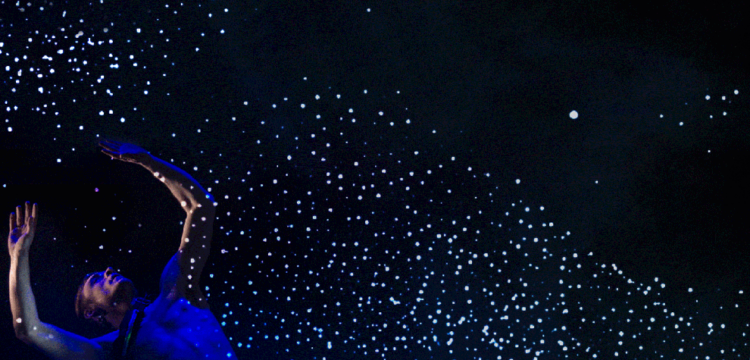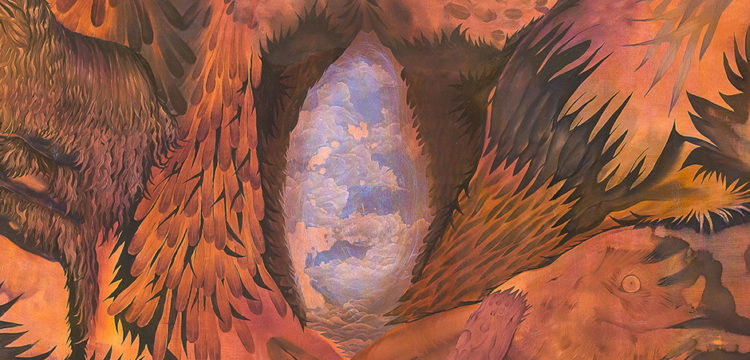The Apocalypse of the New Era
Paintings at the end of the present
In his work, Alessandro Giannì collects aesthetic fragments of social networks and the Internet with the intention of giving them a new existence. In this research there is a rigorous “image economy”. In his works the analogical practice of the painting merges with the use of new media, with the Internet and digital culture investigating the connections between the digital universe, parallel universes and the dreamlike and introspective world of human beings. In his artistic practice, he reuses the symbols of art history to create other landscapes and other images attributable to an indefinite age, causing a short circuit. This text accompanies the exhibition L’apocalisse dell’ora (The Apocalypse of Now), curated by Lorenzo Micheli Gigotti.
Anthropomorphic and twisted forms, with the hidden faces and the stretched lower limbs like ghostly shadows, follow one another as if they were a chorus of demons, framed within sceneries that recall both pre-Renaissance architectural motifs as well as computer screensavers.
This is the iconography that dominates the large-scale oil painting of the artist Alessandro Giannì entitled The Apocalypse of Now. As in the classical repertoire, the apocalypse becomes the pretext for the creation of fantastic and surreal images. Yet in the painting there are no traces of those devilish figures that have dominated the open-eyed nightmares of a culture struggling with the unimaginable. If anything, in Giannì’s work figurative elements appear as portions of a sampled image that multiplies and mirrors itself until it collapses at the center of the painting, thus producing an indescribable figure: something like an alien alphabet, the unexpected calculation of an algorithm, a parallel narration without an end.
The expression “Apocalypse of Now”, besides being the title of the painting, defines two key concepts that place Giannì’s work in the full spirit of our time: on the one hand, there is a reference to catastrophe, the end of the present world as we live it; on the other, understood in its literal meaning, it suggests the conclusion of time and history.

Alessandro Giannì, Simultaneità (detail) 2019. Courtesy the artist
The end of the world is nothing but the world without us, a world deprived of the human presence which reveals a dark abyss made of fog, fragments and horror. The conclusion of time coincides instead with a period that immediately precedes the end, in which the linear and one-sided progress of history collapses under the dreadful weight of a multitude of simultaneous and parallel narratives.
Here, starting from these two intuitions, Giannì’s work tends exactly to a representation of the unimaginable that is above all a form of reality without human being. Everything that was once clear and humanly comprehensible is suddenly dematerialized, reduced to fragments in a paradoxical and intricate combination of horror vacui. There is nothing left but a hint of a figure, a sampling that multiplies, accumulates and merges with other forms. Inevitably, along with the natural landscape that crumbles into unidentifiable details, the representation of the human body decays—that same unambiguous and linear representation that in our cultures continues to be used as the measure of the universe.

Alessandro Giannì, Questa razza di diavoli non conosce regole! video projection and Htc Vive. 2019 3d Modeling: Andrea Papi; programmazione e grafica VR / programming and VR graphic: Weirdo Vanilla (Daniele Monaca e Cosimo Mollica). Ph. Sebastiano Luciano, courtesy AlbumArte
Yet, the human element—both in the sense of the anthropomorphic figures that populate the works of Giannì, as well as the “artist-producer’s gesture”—is still present, perceivable, legible. However, the doubt is that this is an element conceived according to the models of machines and their computing skills – models which, in turn, undermine not only our biological reality as human beings, but also the very concept of time.
Indeed, in Giannì’s work, history is erased in a space-time dimension where the icons and tropes of today – laptops, photoshop filters, the refractions of mobile phones – mix with the anamorphosis, the clichés and the repertoire of classical painting, from Holbein to Parmigianino. The paintings, the collages, the sculptures, and even the virtual reality elaborations of Giannì are compositions in which forms are distorted by a hallucinatory appeal, fluctuating on flat monochrome backgrounds that evokes both the uniform environment of screens as well as the black background of classical painting. In other words, these are works where the digital universe of screens, the internet, algorithms and computational skills coexists with the humanist repertoire of classical painting and the rigor of the Renaissance composition and geometry.
Everything is infused with constant tension between two fields: the human and the machines. In his New Dark Age. Technology and the End of the Future, James Bridle makes an analysis of those places defined as “code/space”, places that represent the intertwining of computation with the physical environment and the experience that one makes of it. “Rather than overlaying and augmenting them, computation becomes a crucial component of them, such that the environment and the experience of it actually ceases to function in the absence of code”. Similarly, the works of Alessandro Giannì reveal (from Latin: apocalypsis and Greek: ἀποκάλυψις: «revelation») a reality that is co-produced by two different origins: the binary electronic matrix, which is programmed and repeats itself to infinity; and the human one made of flaws, errors, and weaknesses.

Alessandro Giannì, Simultaneità, 2019. Ph. Sebastiano Luciano, courtesy AlbumArte

Alessandro Giannì, Senza titolo, 2014. Ph. Sebastiano Luciano, courtesy AlbumArte

Alessandro Giannì, right: Senza titolo, 2018; left: La creazione dello sguardo, 2017. Ph. Sebastiano Luciano, courtesy AlbumArte
More than describing the collapse of the humanist figurative repertoire, Giannì’s paintings seem to evoke the algorithmic aberration of DeepDream, a computer vision program created by Google using an artificial neural network and enhancing the patterns of images, multiplying them until they appear as dreams or hallucinations. It is also in this respect that we can define Giannì a post-internet artist, who is still profoundly aware of the technological importance of the internet in redefining current aesthetics and our own forms of life, belonging to a generation that doesn’t necessarily find its means of expression in telecommunication and data.

Alessandro Giannì, L’apocalisse dell’ora. Exhibition view, AlbumArte, 2019. Ph. Sebastiano Luciano, courtesy AlbumArte
Moreover, it is emblematic how Giannì’s works often originate from a visual element sampled from the web. Whether it’s an anonymous landscape, an ordinary person portrayed in his or her everyday life, or a fragment connected to the repertoire of art, such an element would then undergo a mutant process of multiplications, overlaps, distortions and reflections in pictorial form. At the same time, while it holds true that Giannì draws from the hyper-tropic online world, what stands out is the predilection for a somewhat “ancient” technique such as oil on canvas. On the one hand, this choice emphasizes how his art cannot be classified according to the technological characteristics of its production, but rather in accordance with the themes, motives, and moods of the era in which we are living. On the other hand, thanks to the use of such technique, Giannì’s apocalypse appears to us as the direct product of a true digital medieval age: a new dark age (to return to Bridle’s metaphor) in which the opacity of the machines produces unfamiliar and disturbing post-human imagery.
In this opaque era, in which machines and computational logic are gradually taking over our bodies, our thoughts, our behaviors, and progressively corrode everything surrounding us, human regurgitations and poetically-inspired outbursts are still allowed. It is within this time that the work of Alessandro Giannì finds its place.



